Have you ever wondered how products like watches and iPods go from ideas to something society can’t live without?
University Professor Everett Rogers was also intrigued. In 1962, he studied how new technologies and products find their way from early innovations to mass market successes. In his book “The Diffusion of Innovation”, Rogers wrote that an idea, product, or behavior becomes rooted in society through different segments of our population.
The product takes off slowly after "innovators" pick it up, but when "early adopters” take a shine to it, only then does the product have a chance of changing a society’s status quo.
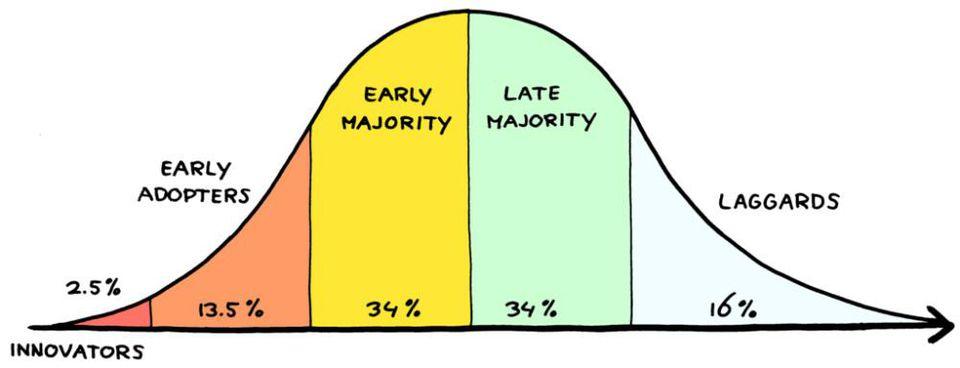
You see, early adopters buy products based on calculated risks and decisions. They see opportunities before they are there, and they’re willing to experiment.
And because of this, they’re notoriously hard to target and sell to unless you’re using contextual targeting strategies. As much as early adopters want to be seen with new products and technologies, they're not guinea pigs. And that's where a lot of businesses get stuck: they know they need to reach early adopters, but they don't know how to lure them into their honey pot.
On the flip side, if you're able to break into the early adopters market and connect with them, it can be a game-changer for your business. Pew Research found that 28% of the US market peg themselves as keen early adopters of technology, so having early adopters in your funnel can boost more than your exposure—it can boost your bottom line as well.
Ready to start selling?
What makes selling to early adopters unique?
Getting early adopters on board and excited about using your product isn't a "nice to have." It's a crucial step in developing your product and pushing it forward into a broader buying market.
Targeting early adopters isn't just about boosting your sales, either. They can give you a lot of crucial feedback about what your product is doing well, and how you can improve it before you start marketing it to the masses.
But what makes them such a unique bunch to target and sell to?
They don’t respond to certain types of marketing
Early adopters don't respond to certain types of marketing. If you try and market to them the same way you plan on marketing to everybody else, your product won't come across as unique or niche, and they won't be interested in it.
If you have any chance of capturing the attention of early adopters, you need to be creative and reach out to them directly. You must give early adopters the feeling that they're getting in on something special—before everyone else.
But why?
Let's break down the mindset of an early adopter. They want to be the person that introduces the product to their friends, family, and into their workplace. In a sense, early adopters want to tell people "Hey, look at this awesome product I found! I think you should try it."
To get this group on board means you have to advertise to them in a smarter way. Targeting early adopters on forums and with non-intrusive ads on specific websites can speak to them at a higher level than just using your marketing budget for mainstream PPC, but we will talk about this more in depth later.
They’re skeptical and critical
Early adopters are hard to please. After all, their reputation is on the line when they announce their shiny new product find to their social circles.
They'll research your product inside and out. They want to make sure that it's going to solve their problem, and they'll seek out experiences and feedback from innovators that have used it to get their feedback. On top of this, they'll want to know that the product is cutting-edge, innovative and is pushing the boundaries of other products in the same field.
Because of this, targeting early adopters can be a double-edged sword. If your product isn't up to scratch, they'll tell the people around them that they've had a bad experience and this can damage your product when you're preparing to launch to the mass market.
They’re social creatures
Early adopters aren’t innovators like Elon Musk or Steve Jobs.
They’re average individuals in society who like innovation. And that's a key difference to remember when you're targeting them. Because of their passion for innovation, they're social creatures and they like to think of themselves as role models in their social circles.
In "The Diffusion of Innovation", Rogers says that those who class themselves as early adopters are more likely to be younger, have higher education, and perceived social status. It's these traits, Rogers says, that allows them to set off a chain reaction of excitement and intrigue amongst their peers when they start talking about a new product.
Early adopters want to be that family member that posts on Facebook about a new product. They need to be an employee in the boardroom that’s found an innovative solution to a problem that’s been dragging the company down. They thrive on discussing innovation when they’re at a bar with their friends.
In fact, doing this helps to maintain their central role in their social circles. They're seen as experts in their social circles, and they tend to create trends amongst their friends and colleagues.
They’re judicious
And they love to appoint themselves to the chief role of being an “opinion leader."
Their social circles look to them to give an opinion on new technology or products and to seek their approval. Their opinions matter to their social circles, because they have knowledge around if a product is going to solve a person's problem.
Because of their willingness to experiment more with new products compared to the early majority, early adopters are also financially stable. They're willing to spend money on products that excite them.
They make calculated decisions
Don't be fooled—early adopters aren't massive risk takers. They make calculated decisions about investing and purchasing a product and take calculated risks.
As you’re likely to target early adopters after innovators (who are much more willing to take a risk on products), it's important to realize that early adopters want proof that they aren't being used as guinea pigs.
To minimize the risk for early adopters, your company can serve up technical insights, testimonials, case studies and behind the scenes perspectives from innovators to encourage them to try the product for themselves.
They will also want to know the future plans of the product if you plan to market it to the masses:
- Who does it appeal to?
- How will it benefit them?
You need to convince early adopters that your product is worth their time, effort, and money. Think of them as investors.
Contextual Targeting Strategies for early adopters
It might seem like early adopters are elusive creatures that need a lot of nurturing and calculated marketing to win them over.
In reality, early adopters tend to have three traits in common:
- They know they have a problem that needs solving
- They know exactly what that problem is
- They're actively looking for a solution
If you keep these traits at the front of your mind and use contextual targeting strategies while building your marketing campaigns, it's easier to offer up your product as a solution to their problem in an innovative way.
Early adopters thrive on the excitement and thrill of a new product, so use these niche strategies to target them before you start targeting the masses.
Strategy 1: Target them in their own neighborhood
Early adopters hang out in their own niche neighborhoods.
They aren't just scrolling on Facebook or Instagram. They're hanging out in low-traffic areas like web forums, YouTube, and even their own Slack channels. Forums like Quora and Reddit are havens for early adopters to talk to each other about new and exciting products.
A quick Google search can unearth these niche forums by punching in:
- "(target audience) community"
- "(target audience) slack channel"
- "(target audience) forum”
- "(target audience) Reddit"
Let’s say your product is geared towards coders, and you want to get early adopters on board to test it out. Google “coders slack channel” and you’ll get this goldmine:
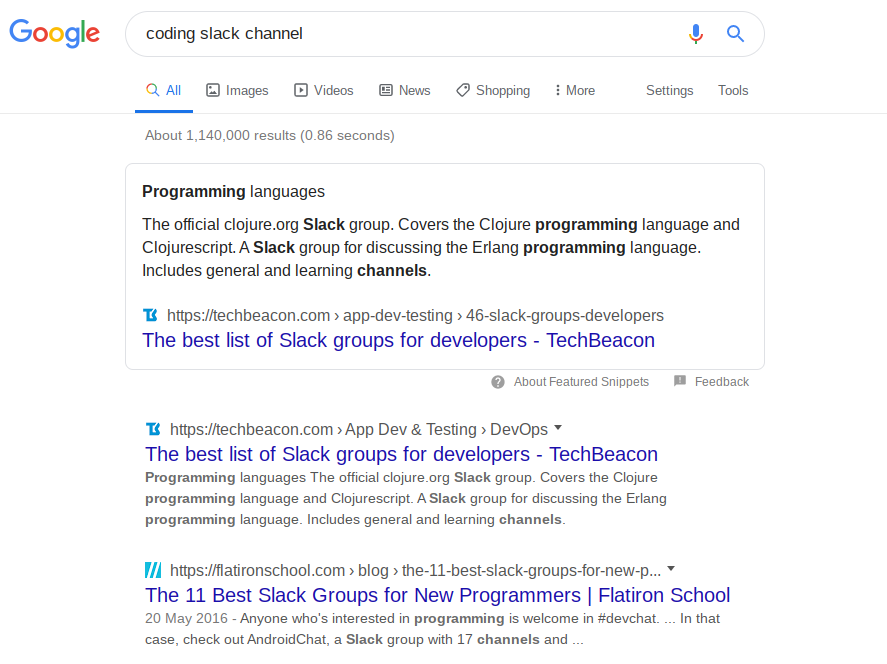
Even if you don't use these channels to promote your product directly, you can still use them to ask for feedback and advice about your product in its early stages. That way, you can pique the interest of any early adopters in the slack channel chats.
Promoting your product across other communities like Twitter and LinkedIn is also a way to talk directly with early adopters and influence their buying decisions. A study by Zeitgeist Research found early adopters use Twitter as a way to create an ongoing and active dialogue about tech.
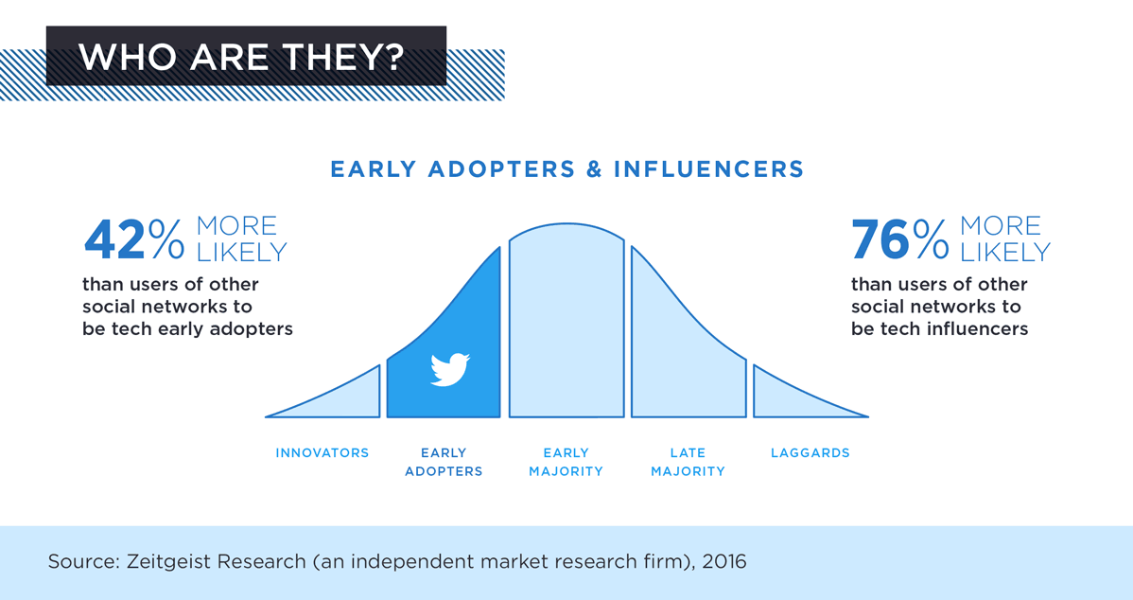
“Twitter provides a platform for these early adopters to broadly and publicly share their opinions, giving them significant influence over a product’s popularity and potential adoption,” the study said.
“This amplification contributes to a 59% greater likelihood of reaching those intending to make consumer technology purchases on Twitter.”
In a way, this makes total sense—Twitter is basically a giant chat room. If you use it right, early adopters will talk about your product for free, offer up trustworthy reviews, and drive other early adopters to your brand. It’s a win-win.
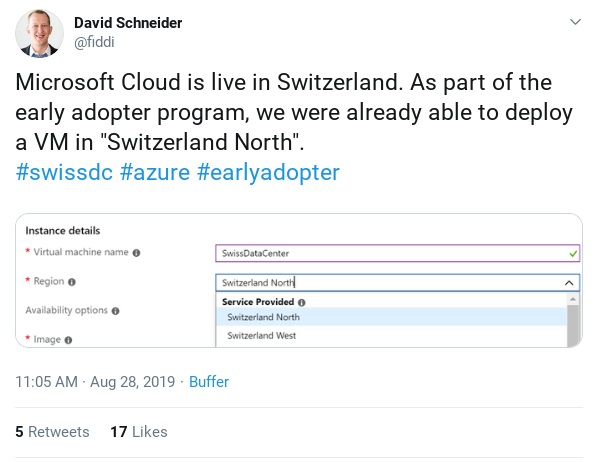
A tweet from an early adopter… telling his peers that he’s an early adopter of new Microsoft Cloud technology. At the very least, this will create some FOMO and intrigue in his social circles.
Strategy 2: Use push-based acquisition
Just because early adopters are hiding in forums doesn't mean they aren't active on mainstream social media.
They just might not be using platforms like Facebook and Instagram to search for their solution. All you have to do is connect the dots and lure them in with highly targeted ads on these platforms.
Precoil Founder David Bland says a push-based acquisition model to finding early adopters works because you're targeting them before they’ve started actively seeking a solution.
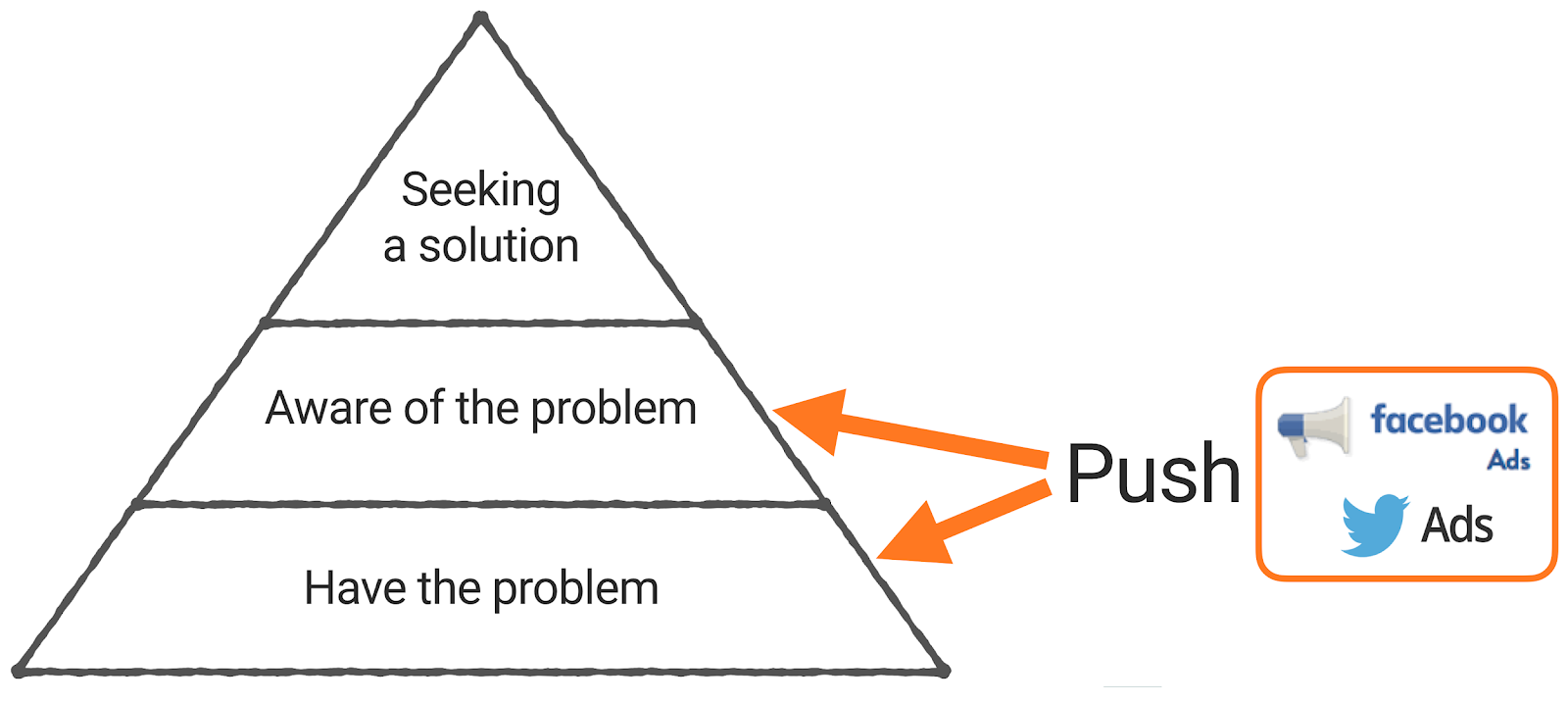
Bland says when companies are building a targeted push for early adopters, it's important to outline:
- Who has this problem in the real world?
- Where do they live?
- What interests do they have?
- Where do they hang out online?
- Why aren't they seeking a solution, and how can we address this?
You can then use these characteristics to create a super-detailed persona of what your ideal early adopters look like, and build targeted ads around it. In fact, Facebook's targeting is so powerful that it even has an option to target "Technology Early Adopters."
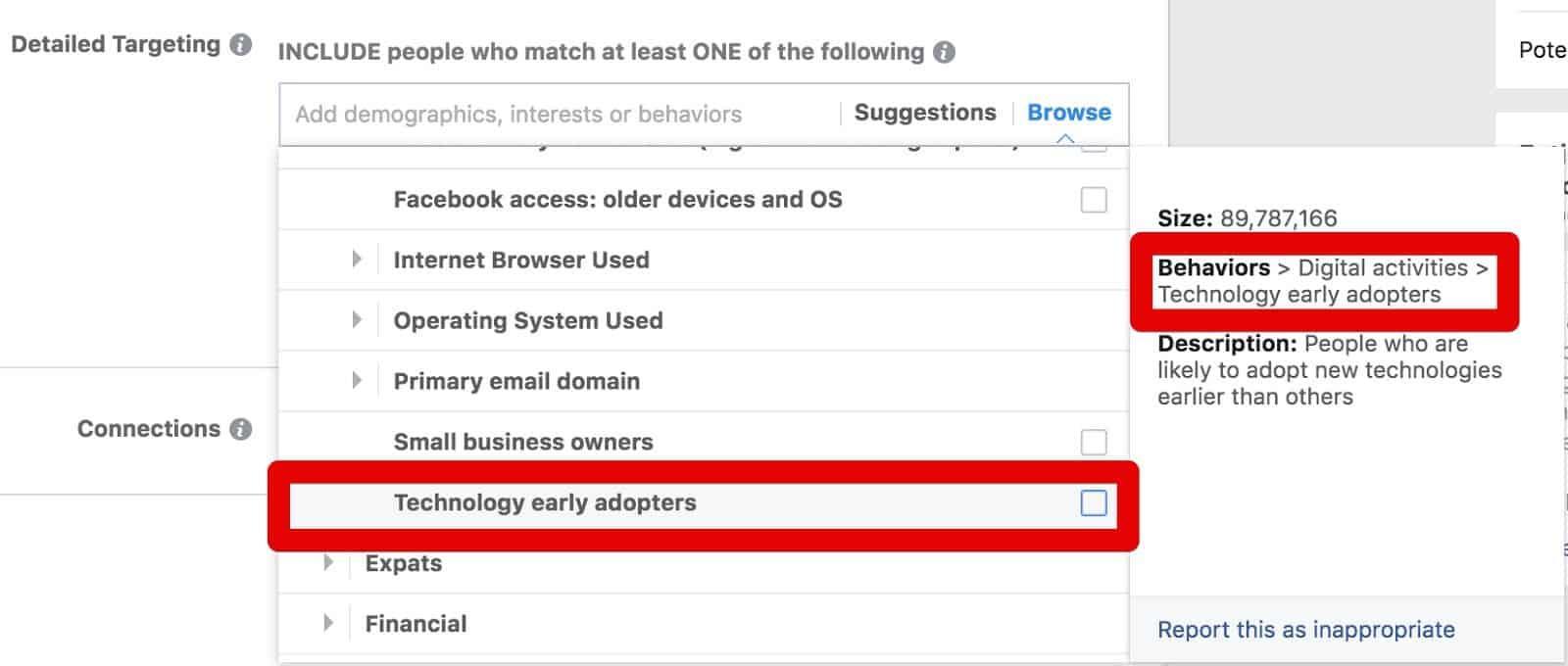
Getting your targeting right means Facebook will seek out early adopters based on their behaviors and characteristics. It's a lazy way of maximizing your ad spend, with minimal effort.
Strategy 3: Get early adopters using your product (even if it isn’t perfect)
Early adopters aren’t perfectionists.
It's important to remember that, even if your offering isn't perfect, early adopters are willing to work with your minimum viable product if it solves their problem. All they want is something that they can put into action and test out.
BDC Communitech Partner Ryan McCartney agrees that early adopters aren't likely to complain about every little glitch in a new product.
“They’re more interested in the result than the customer experience,” he says.
“But pay attention to the feedback they do provide—and ask for it—because it will make your product that much stronger.”
Case in point: Dropbox. Before founder Drew Houston launched the SaaS product (which is now worth $7.42 Billion) to the masses, he asked early adopters on Hacker News for their thoughts:
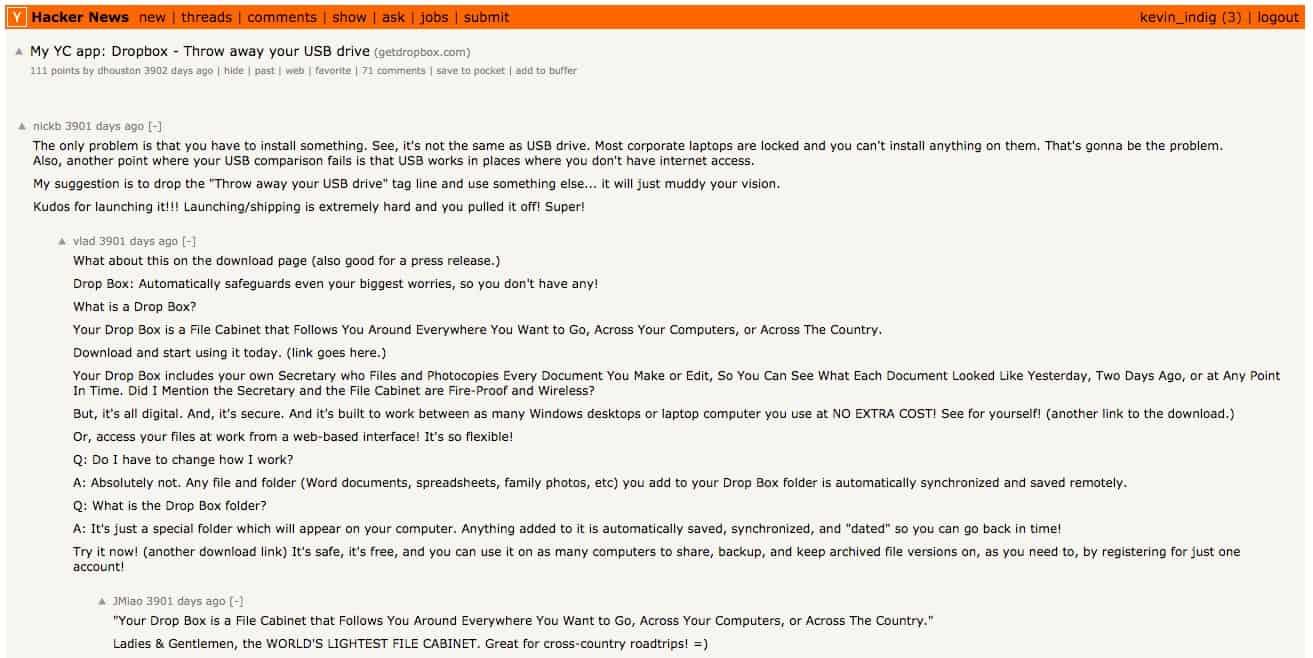
Notice the feedback?
It’s all super useful. It breaks down the product’s positioning and further down the page, potential early adopters start to unpick the technical aspects of the product:
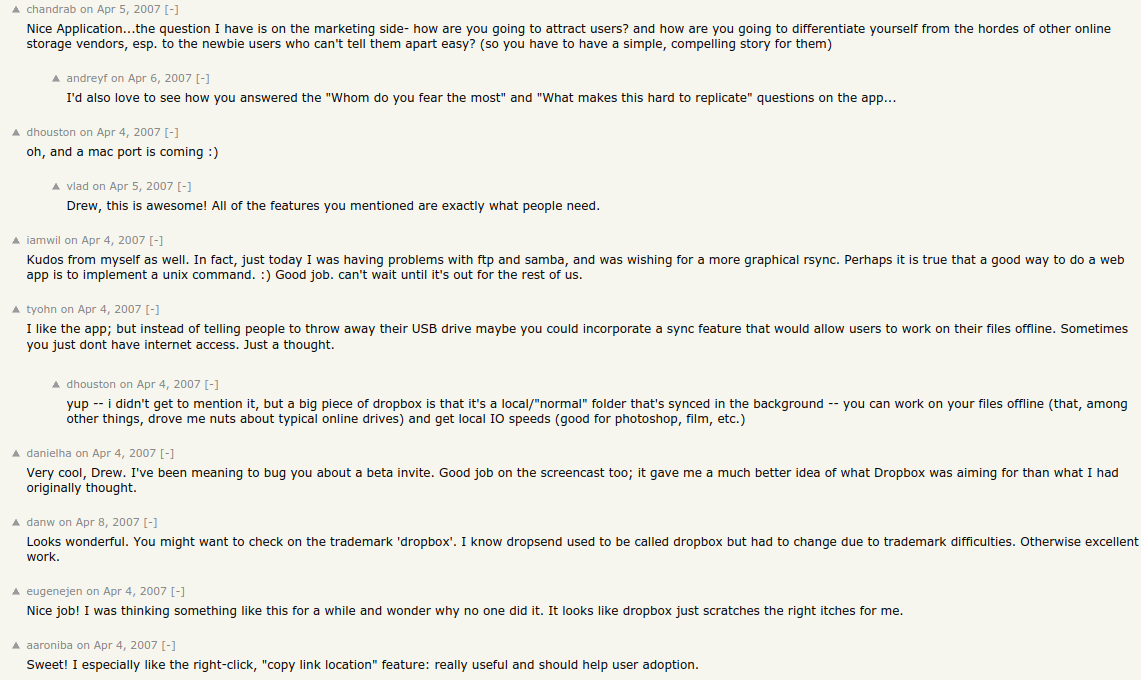
So, what did Houston do? He listened to their concerns and suggestions, and when he launched the product on Digg a year later, the beta waiting list grew to 75,000 in a single day.
But it wasn't time to celebrate just yet. In fact, Dropbox was anything but successful, at least revenue-wise, when it launched.
Houston said the company focused on traditional PPC marketing to push the product—and it bombed. Dropbox was priced at $99, but their typical cost to acquire customers through PPC was an eye-watering $233-388 a pop!
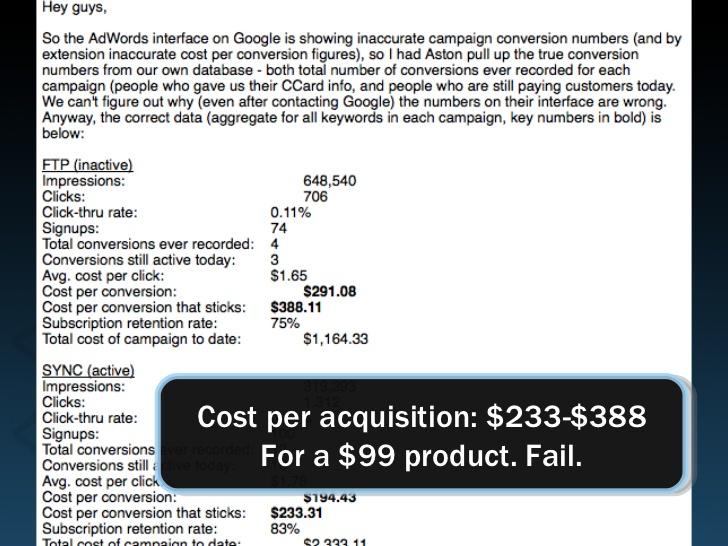
It was then that Houston decided to strip back the way they were marketing and selling the product. He discovered that the typical early adopter to DropBox acted a little differently:
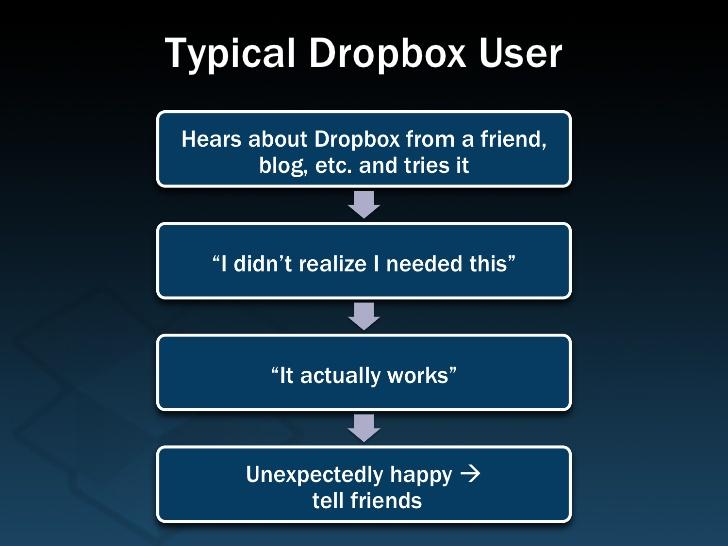
To win them over, Dropbox built a referral campaign in the hope it would supercharge their word-of-mouth marketing. The company offered early adopters 16GB of free Dropbox storage if they referred the product to their friends.
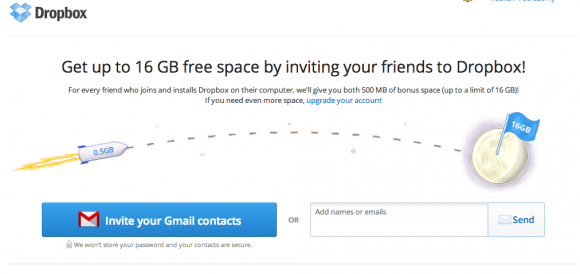
Within 15 months, the company’s user base skyrocketed from 100,000 to 4,000,000.
The lesson here is that to get early adopters on your side, it's crucial to get them seeing value in your product as early as possible, and even offer up a tasty reward as thanks for spreading the word. If you're able to market your product as functional and something that will give an early adopter a competitive edge, you'll already be winning the uphill battle to gather new customers.
Pro-tip: Always ask for feedback
Communities are built on conversation, which is why so many early adopters live in forums.
It's important to use early adopters to your advantage and seek their feedback to help you fine-tune your product. By using surveys and questionnaires, you can gather feedback about what's great about your product, and what needs improvement.
This will also give your product another boost through ownership. If early adopters feel like their input is valued and it has the power to shape the product into something that’s really going to benefit them, they’re more likely to give it. So, make sure you let early adopters know that you’re using their feedback to make the product the best it can be.
Strategy 4: Partner with a premium network
What if you could advertise your product in an early adopters backyard, without having the manual labor of searching and posting in forums yourself?
By partnering with a network which only chooses good publishers, early adopters will only be shown ads on websites they already like. This will give you an unfair advantage because you'll be able to advertise on websites that your target audience knows and trusts. For example, using a premium advertising partner like BuySellAds can help you sell specifically to tech-focused early adopters through its invite-only ad networks like Carbon.
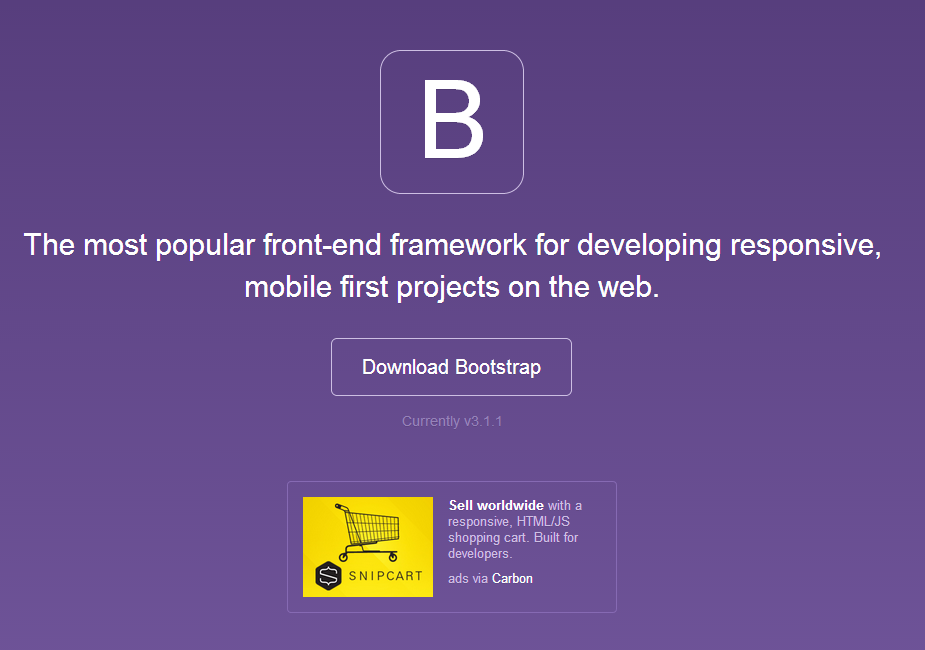
An example of a targeted ad on the Carbon network
These types of ads work for a couple of different reasons. First off, publishers on the Carbon network only serve one ad per page in a non-intrusive format, so your target audience doesn’t get overwhelmed by a bunch of ads being thrown at them.
Secondly, the target audience (in this case, early adopters) can support publishers that serve non-intrusive ads, allowing them to "payback" publishers for time spent on quality content. Finally, Carbon ads are a part of Adblock Plus' Acceptable Ads program, so marketers don't need to worry about their advertising efforts being blocked. Most Adblock Plus users will see carbon ads without any issues.
Wrapping Up
Early adopters aren't mythical beings or impossible to win over—you just have to know how to market your product to them on their own turf.
Early adopters will play a key role in taking your product from hype to reality. And if your company has just developed a new product, no matter what industry you're trying to penetrate, recruiting a group of early adopters is crucial for building loyalty and trust.
But getting noticed is easier said than done, and that's why a lot of businesses who don't know how to target and sell to early adopters end up wasting a ton of marketing spend.
Instead, strategically pick out niche marketing opportunities, build smarter campaigns, and target early adopters in their own backyard. If an early adopter thinks they've found a product before the mass market has, they can end up doing your most powerful marketing for you—recommending you in their social circles.


